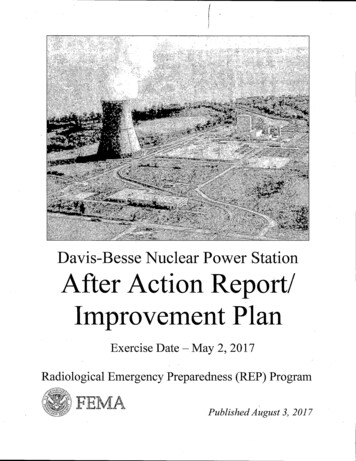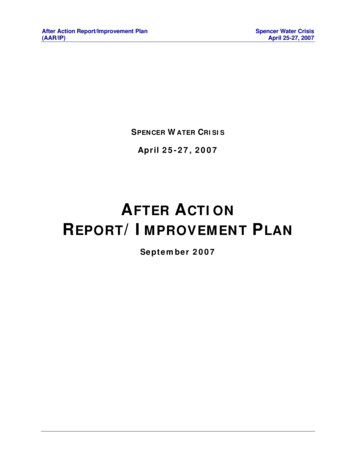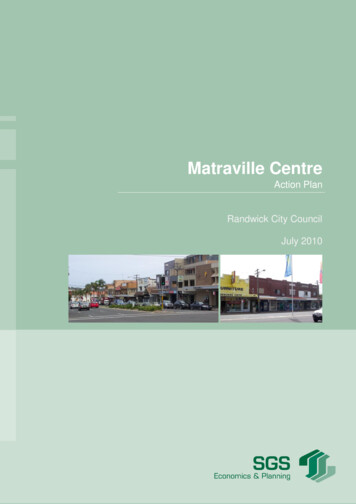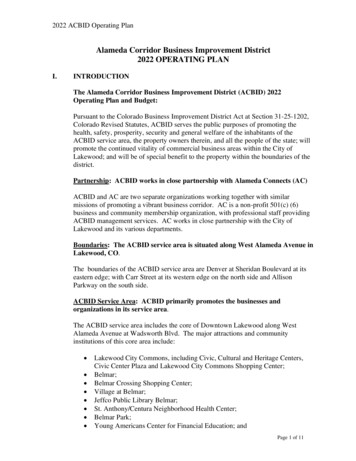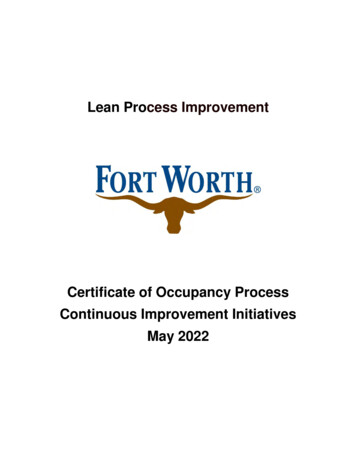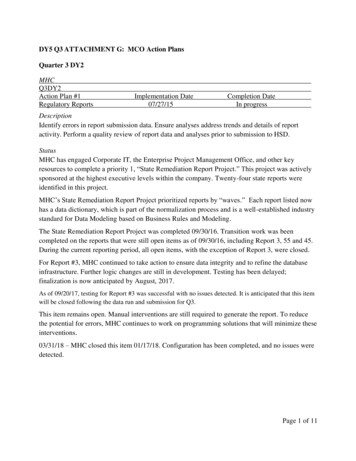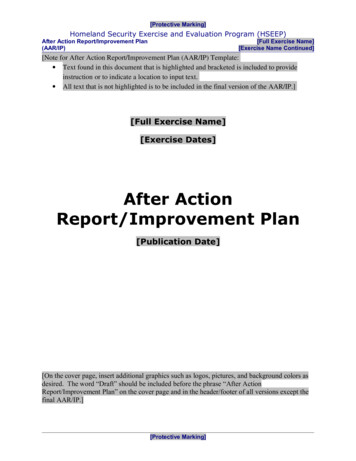
Transcription
[Protective Marking]Homeland Security Exercise and Evaluation Program (HSEEP)After Action Report/Improvement Plan(AAR/IP)[Full Exercise Name][Exercise Name Continued][Note for After Action Report/Improvement Plan (AAR/IP) Template: Text found in this document that is highlighted and bracketed is included to provideinstruction or to indicate a location to input text. All text that is not highlighted is to be included in the final version of the AAR/IP.][Full Exercise Name][Exercise Dates]After Action Report/Improvement Plan [Publication Date][On the cover page, insert additional graphics such as logos, pictures, and background colors asdesired. The word “Draft” should be included before the phrase “After ActionReport/Improvement Plan” on the cover page and in the header/footer of all versions except thefinal AAR/IP.][Protective Marking]
[Protective Marking]Homeland Security Exercise and Evaluation Program (HSEEP)After Action Report/Improvement Plan(AAR/IP)[Full Exercise Name] [Exercise Name Continued] This page is intentionally blank.[Protective Marking]
[Protective Marking]Homeland Security Exercise and Evaluation Program (HSEEP)After Action Report/Improvement Plan(AAR/IP)[Full Exercise Name] [Exercise Name Continued] HANDLING INSTRUCTIONS1. The title of this document is [complete and formal title of document].2. The information gathered in this AAR/IP is classified as [For Official Use Only (FOUO)]and should be handled as sensitive information not to be disclosed. This document should besafeguarded, handled, transmitted, and stored in accordance with appropriate securitydirectives. Reproduction of this document, in whole or in part, without prior approval from[agency] is prohibited.3. At a minimum, the attached materials will be disseminated only on a need-to-know basisand when unattended, will be stored in a locked container or area offering sufficientprotection against theft, compromise, inadvertent access, and unauthorized disclosure.4. Points of Contact: [List all points of contact.][Federal POC:]NameTitleAgencyStreet AddressCity, State ZIPxxx-xxx-xxxx (office)xxx-xxx-xxxx (cell)e-mail[Exercise Director:] Name Title AgencyStreet AddressCity, State ZIPxxx-xxx-xxxx (office)xxx-xxx-xxxx (cell)e-mailHandling Instructions1[Protective Marking] [Jurisdiction]
[Protective Marking]Homeland Security Exercise and Evaluation Program (HSEEP)After Action Report/Improvement Plan(AAR/IP)[Full Exercise Name] [Exercise Name Continued] This page is intentionally blank.Handling Instructions2[Protective Marking] [Jurisdiction]
[Protective Marking]Homeland Security Exercise and Evaluation Program (HSEEP)After Action Report/Improvement Plan(AAR/IP)[Full Exercise Name] [Exercise Name Continued] CONTENTS Administrative Handling Instructions.1 Contents.3 Executive Summary.5 Section 1: Exercise Overview.[p] Exercise Details.[p] Exercise Planning Team Leadership.[p] Participating Organizations.[p] Section 2: Exercise Design Summary.[p] Exercise Purpose and Design.[p] Capabilities and Activities Identified for Demonstration.[p] Scenario Summary.[p] Planned Simulations.[p] Section 3: Analysis of Capabilites.[p] [Capability 1] .[p] [Capability 2] .[p] [Capability 3] .[p] Section 4: Conclusion.[p] Appendix A: Improvement Plan.[p] Appendix B: Lessons Learned [Optional].[p] Appendix C: Participant Feedback Summary [Optional].[p] Appendix D: Exercise Events Summary Table [Optional].[p] Appendix E: Performance Ratings [Optional].[p] Appendix F: Acronyms.[p] [If an AAR contains graphics, figures, or tables, they should be numbered and listed in theContents section (e.g. Figure 1, Table 1, etc.).Contents3[Protective Marking] [Jurisdiction]
[Protective Marking]Homeland Security Exercise and Evaluation Program (HSEEP)After Action Report/Improvement Plan(AAR/IP)[Full Exercise Name] [Exercise Name Continued] This page is intentionally blank.Contents4[Protective Marking] [Jurisdiction]
[Protective Marking]Homeland Security Exercise and Evaluation Program (HSEEP) After Action Report/Improvement Plan(AAR/IP)[Full Exercise Name] [Exercise Name Continued] EXECUTIVE SUMMARY[When writing the Executive Summary, keep in mind that this section may be the only part ofthe AAR/IP that some people will read. Introduce this section by stating the full name of theexercise and providing a brief overview of the exercise. This brief overview should discuss whythe exercise was conducted; the exercise objectives; and what Target Capabilities List (TCL)capabilities, activities, and scenario(s) were used to achieve those objectives. All of these areaswill be discussed in more detail in the subsequent chapters of the AAR/IP. In addition, theExecutive Summary may be used to summarize any high-level observations that cut acrossmultiple capabilities.]The [agency or jurisdiction] [scenario type] [exercise type] exercise [exercise name] wasdeveloped to test [agency or jurisdiction]’s [Capability 1], [Capability 2], and [Capability 3]capabilities. The exercise planning team was composed of numerous and diverse agencies,including [list of agencies participating in planning team]. The exercise planning team discussed[include a brief overview of the major issues encountered, discussed, and resolved during theexercise planning process. Topics to address in this section could include the length of theplanning process, the reasoning behind the planning team’s choice of objectives to exercise, etc.]Based on the exercise planning team’s deliberations, the following objectives were developed for[exercise name]: Objective 1: [Insert 1 sentence description of the exercise objective] Objective 2: [Insert 1 sentence description of the exercise objective] Objective 3: [Insert 1 sentence description of the exercise objective]The purpose of this report is to analyze exercise results, identify strengths to be maintained andbuilt upon, identify potential areas for further improvement, and support development ofcorrective actions.[In general, the major strengths and primary areas for improvement should be limited to threeeach to ensure the Executive Summary is high-level and concise.]Major StrengthsThe major strengths identified during this exercise are as follows: [Use complete sentences to describe each major strength.] [Additional major strength] [Additional major strength]Executive Summary5[Protective Marking] [Jurisdiction]
[Protective Marking]Homeland Security Exercise and Evaluation Program (HSEEP)After Action Report/Improvement Plan(AAR/IP)[Full Exercise Name] [Exercise Name Continued] Primary Areas for ImprovementThroughout the exercise, several opportunities for improvement in [jurisdiction/organizationname]’s ability to respond to the incident were identified. The primary areas for improvement,including recommendations, are as follows: [Use complete sentences to state each primary area for improvement and itsassociated key recommendation(s).] [Additional key recommendation] [Additional key recommendation][End this section by describing the overall exercise as successful or unsuccessful, and briefly state the areas in which subsequent exercises conducted by these jurisdictions and/or organizations should focus.] Executive Summary6[Protective Marking] [Jurisdiction]
[Protective Marking]Homeland Security Exercise and Evaluation Program (HSEEP)After Action Report/Improvement Plan(AAR/IP)[Full Exercise Name] [Exercise Name Continued] SECTION 1: EXERCISE OVERVIEW [Information in the Exercise Overview should be “structured data”—written as a list rather thanin paragraph form—in order to facilitate preparation of other parts of the AAR/IP, maintainconsistency within AAR/IPs, and facilitate the analysis of AAR/IPs for program reporting.]Exercise DetailsExercise Name[Insert formal name of exercise, which should match the name in the header.]Type of Exercise[Insert the type of exercise as described in Homeland Security Exercise EvaluationProgram Volume I (e.g. seminar, workshop, drill, game, tabletop, functional exercise, orfull-scale exercise.]Exercise Start Date[Insert the month, day, and year that the exercise began.]Exercise End Date[Insert the month, day, and year that the exercise ended.]Duration[Insert the total length of the exercise, in day or hours, as appropriate.]Location[Insert all applicable information regarding the specific location of the exercise; includingany city, State, Federal region, international country, or military installation.]Sponsor[Insert the name of the Federal agency or agencies that sponsored the exercise, as well asany co-sponsors if applicable. Also list any applicable points of contacts.]Program[Insert the name of the program (e.g. Fiscal Year 2007 State Homeland Security GrantProgram) from which exercise funding originated.]Mission[Insert the appropriate mission areas of the exercise (e.g. Prevent, Protect, Response,and/or Recovery).]Capabilities[Insert a list of the target capabilities addressed within the exercise.]Scenario Type[Name the exercise scenario type (e.g. chemical release).]Exercise Planning Team[The name of each member of the planning team leadership should be listed along with their role Section 1: Exercise Overview7[Protective Marking] [Jurisdiction]
[Protective Marking]Homeland Security Exercise and Evaluation Program (HSEEP)After Action Report/Improvement Plan(AAR/IP)[Full Exercise Name] [Exercise Name Continued] in the exercise, organizational affiliation, job title, mailing address, phone number, and e-mailaddress.]Participating Organizations [Insert a list of the individual participating organizations or agencies, including Federal, State,Tribal, non-governmental organizations (NGOs), local and international agencies, and contractsupport companies as applicable.]Number of Participants[Insert a list of the total number of each of the following exercise participants, asapplicable: Players Controllers Evaluators Facilitators Observers Victim Role Players]Section 1: Exercise Overview8[Protective Marking] [Jurisdiction]
[Protective Marking]Homeland Security Exercise and Evaluation Program (HSEEP)After Action Report/Improvement Plan(AAR/IP)[Full Exercise Name] [Exercise Name Continued] SECTION 2: EXERCISE DESIGN SUMMARY [The Exercise Design Summary is intended to provide a summary of the exercise designprocess.]Exercise Purpose and Design [This section should be a brief (one-to-two paragraph) summation of why the exercise wasconducted and what the exercise participants hoped to learn. It should also include a briefhistory of how the exercise was organized, designed, funded, etc.]Exercise Objectives, Capabilities, and Activities [The purpose of this section is to list exercise objectives and align them with associatedcapabilities from the Target Capabilities List (TCL). For each TCL capability, there is anExercise Evaluation Guide (EEG) which lists specific activities which must be performed todemonstrate a capability. In addition to TCL capabilities, the EEG activities relevant to eachobjective should also be included in this section. Begin this section with the following text.]Capabilities-based planning allows for exercise planning teams to develop exercise objectivesand observe exercise outcomes through a framework of specific action items that were derivedfrom the Target Capabilities List (TCL). The capabilities listed below form the foundation forthe organization of all objectives and observations in this exercise. Additionally, each capabilityis linked to several corresponding activities and tasks to provide additional detail.Based upon the identified exercise objectives below, the exercise planning team has decided todemonstrate the following capabilities during this exercise: Objective 1: [Insert a one sentence description of each objective].[Capability Title]: [Activity 1]; [Activity 2]; and [Activity 3].[Capability Title]: [Activity 1]; [Activity 2]; and [Activity 3].Scenario Summary [For an operations-based exercise, this section should summarize the scenario or situationinitially presented to players, subsequent key events introduced into play, and the time in whichthese events occurred. For a discussion-based exercise, this section should outline the scenarioused and/or modules presented to participants.]Section 2: Exercise Design Summary9[Protective Marking] [Jurisdiction]
[Protective Marking]Homeland Security Exercise and Evaluation Program (HSEEP)After Action Report/Improvement Plan(AAR/IP)[Full Exercise Name] [Exercise Name Continued] SECTION 3: ANALYSISOFCAPABILITIESThis section of the report reviews the performance of the exercised capabilities, activities, andtasks. In this section, observations are organized by capability and associated activities. Thecapabilities linked to the exercise objectives of [full exercise name] are listed below, followed bycorresponding activities. Each activity is followed by related observations, which includereferences, analysis, and recommendations.[The format for Chapter 3, as described above, represents the preferred order for analysis ofexercise observations. However, observations that are cross-cutting and do not apply to one,specific activity within the capability should be listed first, directly under the capabilitysummary. Below the cross-cutting observations, you may then present the complete list ofactivities which apply to the observation.]CAPABILITY 1: [CAPABILITY NAME]Capability Summary: [Include a detailed overview of the capability, drawn from the TCLcapability description, and a description of how the capability was performed during anoperations-based exercise or addressed during a discussion-based exercise. The exact length ofthis summary will depend on the scope of the exercise.]Activity 1.1: [Using the EEGs, identify the activity to which the observation(s) below pertain.]Observation 1.1: [Begin this section with a heading indicating whether the observation is a“Strength” or an “Area for Improvement.” A strength is an observed action, behavior,procedure, and/or practice that is worthy of recognition and special notice. Areas forimprovement are those areas in which the evaluator observed that a necessary task was notperformed or that a task was performed with notable problems. Following this heading, inserta short, complete sentence that describes the general observation.]References: [List relevant plans, policies, procedures, laws, and/or regulations, orsections of these plans, policies, procedures, laws, and/or regulations. If no referencesapply to the observation, it is acceptable to simply list “N/A” or “Not Applicable.”][Name of the task and the applicable plans, policies, procedures, laws,1.and/or regulations and 1-2 sentences describing their relation to the task]2.[Name of the task and the applicable plans, policies, procedures, laws,and/or regulations and 1-2 sentences describing their relation to the task]3.[Name of the task and the applicable plans, policies, procedures, laws,and/or regulations and 1-2 sentences describing their relation to the task]Analysis: [The analysis section should be the most detailed section of Chapter 3.Include a description of the behavior or actions at the core of the observation, as well as abrief description of what happened and the consequence(s) (positive or negative) of theaction or behavior. If an action was performed successfully, include any relevantSection 3: Analysis of Capabilities10[Protective Marking] [Jurisdiction]
[Protective Marking]Homeland Security Exercise and Evaluation Program (HSEEP) After Action Report/Improvement Plan(AAR/IP)[Full Exercise Name] [Exercise Name Continued] innovative approaches utilized by the exercise participants. If an action was notperformed adequately, the root-causes contributing to the shortcoming must beidentified.]Recommendations: [Insert recommendations to address identified areas forimprovement, based on the judgment and experience of the evaluation team. If theobservation was identified as a strength, without corresponding recommendations, insert“None.]1.[Complete description of recommendation]2.[Complete description of recommendation]3.[Complete description of recommendation][Continue to add additional observations, references, analyses, and recommendations for each capability as necessary. Maintain numbering convention to allow for easy reference.] Section 3: Analysis of Capabilities11[Protective Marking] [Jurisdiction]
[Protective Marking]Homeland Security Exercise and Evaluation Program (HSEEP)After Action Report/Improvement Plan(AAR/IP)[Full Exercise Name] [Exercise Name Continued] SECTION 4: CONCLUSION [This section is a conclusion for the entire document. It provides an overall summary to the report. It should include the demonstrated capabilities, lessons learned, major recommendations,and a summary of what steps should be taken to ensure that the concluding results will help tofurther refine plans, policies, procedures, and training for this type of incident.Subheadings are not necessary and the level of detail in this section does not need to be ascomprehensive as that in the Executive Summary.]Section 4: Conclusion12[Protective Marking] [Jurisdiction]
[Protective Marking]Homeland Security Exercise and Evaluation Program (HSEEP)After Action Report/Improvement Plan(AAR/IP)[Full Exercise Name][Exercise Name Continued]APPENDIX A: IMPROVEMENT PLANThis IP has been developed specifically for [identify the State, county, jurisdiction, etc., as applicable] as a result of [full exercisename] conducted on [date of exercise]. These recommendations draw on both the After Action Report and the After ActionConference. [The IP should include the key recommendations and corrective actions identified in Chapter 3: Analysis ofCapabilities, the After Action Conference, and the EEGs. The IP has been formatted to align with the Corrective Action ProgramSystem.]Table A.1 Improvement Plan MatrixCapability Observation Title[Capability1:CapabilityName]1. Observation 1Recommendation1.1 InsertRecommendation 11.2 InsertRecommendation 22. Observation 22.1 InsertRecommendation 1Appendix A: Improvement PlanCorrective ActionDescriptionCapabilityElement1.1.1 InsertCorrective Action11.1.2 InsertCorrective Action2PlanningPlanning1.2.1 InsertCorrective Action11.2.2 InsertCorrective Action22.1.1 InsertCorrective Action12.1.2 InsertCorrective Action2PrimaryResponsibleAgencyState X EMAAgencyCompletionStart DatePOCDateEMADirectorDec 1,2006Sep 1,2007State X EMSSystemEMSSystemDirectorDec 1,2006Feb 1,2007TrainingState X EMAEMADirectorDec 1,2006Jan 1,2007Systems/EquipmentState X EMAEMADirectorDec 1,2006Mar 15,2007PlanningState X EMSSystemDec 1,2006Jan 15,2007Systems/EquipmentState X EMAEMSSystemDirectorEMADirectorDec 1,2006Jan 1,200713[Jurisdiction][Protective Marking]
[Protective Marking]Homeland Security Exercise and Evaluation Program (HSEEP)After Action Report/Improvement Plan(AAR/IP)[Full Exercise Name] [Exercise Name Continued] [Optional]APPENDIX B: LESSONS LEARNEDWhile the After Action Report/Improvement Plan includes recommendations which supportdevelopment of specific post-exercise corrective actions, exercises may also reveal lessonslearned which can be shared with the broader homeland security audience. The Department ofHomeland Security (DHS) maintains the Lessons Learned Information Sharing (LLIS.gov)system as a means of sharing post-exercise lessons learned with the emergency responsecommunity. This appendix provides jurisdictions and organizations with an opportunity tonominate lessons learned from exercises for sharing on LLIS.gov.For reference, the following are the categories and definitions used in LLIS.gov: Lesson Learned: Knowledge and experience, positive or negative, derived fromactual incidents, such as the 9/11 attacks and Hurricane Katrina, as well as thosederived from observations and historical study of operations, training, and exercises. Best Practices: Exemplary, peer-validated techniques, procedures, good ideas, orsolutions that work and are solidly grounded in actual operations, training, and exerciseexperience. Good Stories: Exemplary, but non-peer-validated, initiatives (implemented byvarious jurisdictions) that have shown success in their specific environments and thatmay provide useful information to other communities and organizations. Practice Note: A brief description of innovative practices, procedures, methods,programs, or tactics that an organization uses to adapt to changing conditions or toovercome an obstacle or challenge.Exercise Lessons Learned[Insert an account of any observations nominated for inclusion in the DHS LLIS.gov system. Ifthere are not any nominations, a simple statement to that effect should be included here.]Appendix B: Lessons Learned14[Protective Marking] [Jurisdiction]
[Protective Marking]Homeland Security Exercise and Evaluation Program (HSEEP)After Action Report/Improvement Plan(AAR/IP)[Full Exercise Name] [Exercise Name Continued] [Optional]APPENDIX C: PARTICIPANT FEEDBACK SUMMARY [Provided in this section is a sample Participant Feedback Form, which should be distributed toexercise participants at a post-exercise hot wash. Appendix C of the AAR/IP should provide asummary of the feedback received through this form.]PARTICIPANT FEEDBACK FORMExercise Name: [Full Exercise Name] Exercise Date: [Date]Participant aluatorPART I: RECOMMENDATIONS AND CORRECTIVE ACTIONS1. Based on the exercise today and the tasks identified, list the top 3 strengths and/or areas that need improvement.2.Is there anything you saw in the exercise that the evaluator(s) might not have been able to experience, observe,and record?3. Identify the corrective actions that should be taken to address the issues identified above. For each correctiveaction, indicate if it is a high, medium, or low priority.4. Describe the corrective actions that relate to your area of responsibility. Who should be assigned responsibilityfor each corrective action?Appendix C: Participant Feedback Form15 [Protective Marking] [Jurisdiction]
[Protective Marking]Homeland Security Exercise and Evaluation Program (HSEEP) After Action Report/Improvement Plan(AAR/IP)[Full Exercise Name] [Exercise Name Continued] 5. List the applicable equipment, training, policies, plans, and procedures that should be reviewed, revised, ordeveloped. Indicate the priority level for each.PART II – EXERCISE DESIGN AND CONDUCT: ASSESSMENTPlease rate, on a scale of 1 to 5, your overall assessment of the exercise relative to the statements provided below,with 1 indicating strong disagreement with the statement and 5 indicating strong agreement.Table C.1: Participant AssessmentAssessment FactorStronglyDisagreeStronglyAgreea.The exercise was well structured and organized.12345b.The exercise scenario was plausible and realistic.The facilitator/controller(s) was knowledgeableabout the area of play and kept the exercise ontarget.The exercise documentation provided to assist inpreparing for and participating in the exercise wasuseful.Participation in the exercise was appropriate forsomeone in my position.The participants included the right people in termsof level and mix of disciplines.This exercise allowed my agency/jurisdiction topractice and improve priority capabilities.After this exercise, I believe myagency/jurisdiction is better prepared to dealsuccessfully with the scenario that was .f.g.h.PART III – PARTICIPANT FEEDBACKPlease provide any recommendations on how this exercise or future exercises could be improved or enhanced.Appendix C: Participant Feedback Form16 [Protective Marking] [Jurisdiction]
[Protective Marking]Homeland Security Exercise and Evaluation Program (HSEEP)After Action Report/Improvement Plan(AAR/IP)[Full Exercise Name] [Exercise Name Continued] Appendix C: Participant Feedback Form17[Protective Marking] [Jurisdiction]
[Protective Marking]Homeland Security Exercise and Evaluation Program (HSEEP)After Action Report/Improvement Plan(AAR/IP)[Full Exercise Name] [Exercise Name Continued] [Optional]APPENDIX D: EXERCISE EVENTS SUMMARY TABLE [In formulating its analysis, the evaluation team may assemble a timeline of key exercise events.While it is not necessary to include this timeline in the main body of the AAR/IP, the evaluationteam may find value in including it as an appendix. If so, this section should summarize whatactually happened during the exercise in a timeline table format. Focus of this section is on whatinputs were actually presented to the players and what actions the players took during theexercise. Successful development of this section is aided by the design, development, andplanning actions of the exercise design team. Prior to the exercise, the exercise design teamshould have developed a timeline of anticipated key events.An example of the format for the Exercise Events Summary Table is presented below.]Table D.1: Exercise Events SummaryDateTimeScenario Event,Simulated Player Inject,Player Action02/20/0602/20/0609000902Scenario EventPlayer Action02/20/0602/20/0609150940Player ActionSimulated Player InjectEvent/ActionExplosion and injuries reported at subway station 13Subway services stopped in accordance withprotocols; notifications startedEvacuation ordered for planning zone 2ATraffic at a standstill on major egress route 1 reportedto players (Response generated issue becausepersonnel to staff traffic control points were notdeployed)Appendix D: Exercise Events Summary Table 18[Protective Marking] [Jurisdiction]
[Protective Marking]Homeland Security Exercise and Evaluation Program (HSEEP) After Action Report/Improvement Plan(AAR/IP)[Full Exercise Name] [Exercise Name Continued] [Optional]APPENDIX E: PERFORMANCE RATING[When a jurisdiction/organization elects to use performance ratings, or when initiatives require a rating within the AAR/IP, the following approach can be used. A qualitative performance rating is assigned to each activity demonstrated within its capability area. The performance rating is based on a systemic review by the lead evaluator of exercise performance based on evaluator analysis of how well the participants demonstrated the capability outcome. The results should be summarized within this appendix and should be based on the supporting narrative contained within the body of the AAR/IP.] The performance rating categories refer to how well each activity was performed during theexercise and are detailed in the table below.Table E.1: Performance RatingsRatingDescriptionPerformed without ChallengesThe performance measures and tasks associated with theactivity were completed in a manner that achieved theobjective(s) and did not negatively impact the performance ofother activities. Performance of this activity did not contributeto additional health and/or safety risks for the public or foremergency workers, and it was conducted in accordance withapplicable plans, policies, procedures, regulations, and laws.Performed with Some Challenges,but AdequatelyThe performance measures and tasks associated with theactivity were completed in a manner that achieved theobjective(s) and did not negatively impact the performance ofother activities. Performance of this activity did not contributeto additional health and/or safety risks for the public or foremergency workers, and it was conducted in accordance withapplicable plans, policies, procedures, regulations, and laws.However, opportunities to enhance effectiveness and/orefficiency were identified.Performed with Major ChallengesThe performance measures and tasks associated with theactivity were completed in a manner that achieved theobjective(s), but some or all of the following were observed:demonstrated performance had a negative impact on theperformance of other activities; contributed to additional healthand/or safety risks for the public or for emergency workers;and/or, was not conducted in accordance with applicable plans,policies, procedures, regulations, and laws.Unable to be PerformedAppendix E: Performance RatingThe performance measures and tasks associated with theactivity were not performed in a manner that achieved theobjective(s).19[Protective Marking] [Jurisdiction]
[Protective Marking]Homeland Security Exercise and Evaluation Program (HSEEP) After Action Report/Improvement Plan(AAR/IP)[Full Exercise Name] [Exercise Name Continued] APPENDIX F
After Action Report/Improvement Plan [Full Exercise Name] (AAR/IP) [Exercise Name Continued] S. ECTION . 1: E. XERCISE . O. VERVIEW [Information in the Exercise Overview should be "structured data"—written as a list rather than in paragraph form—in order to facilitate preparation of other parts of the AAR/IP, maintain

